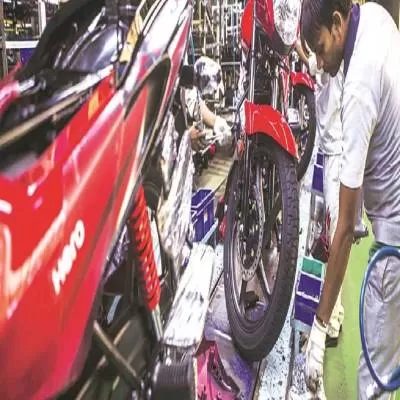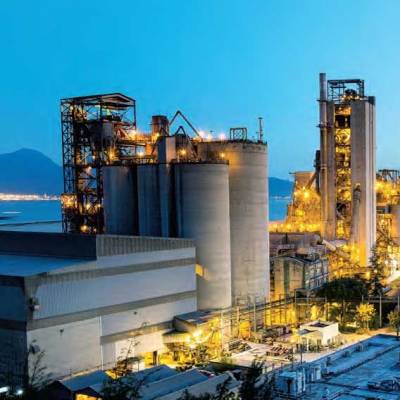- Home
- Building Material
- Cement
- End Game
End Game
While the Olympic Games enable the host country to showcase its construction skills and capabilities for innovation, the applause overshadows the loss to the local building trade and the economy, writes ADITI MATHUR.
After seven years of rigorous planning and an investment of about $11 billion, the 2012 Olympics kicked off on July 27 in London. More than just a testing ground for athletes, events such as these are a challenge to host nations to show their potential to host a majestic extravaganza and build enormous venues like London's Legacy Stadium, Beijing's Bird's Nest and Sydney's Olympic. But amid all the applause and accolades, one question still resounds: does the local building trade win?
The local perspective
Six months prior to the games, the UK construction industry had started worrying about the fate of local construction and demolition sectors. The discontinuity in utility services and steps taken by local authorities for the smooth functioning of the games had caused delays to ongoing construction projects. London and the South East, the hub of the UK construction industry, have the maximum workload, to the tune of $22 billion in Greater London alone. Though the margins in these areas are not too high, there are still hopes to provide a momentary sanctuary from the economic misery. Unfortunately, the arrangements for the Olympics created major problems like stalled and delayed work, just at a time when the industry and economy as a whole could least afford it. Even the work was heavily affected by Olympics-related road closures as effective and easy movement of men and machines are the basics of efficient construction management. The transportation system had succumbed to the increasing pressure of tourist inflow. This proved an additional obstacle for regular construction activities around the country.
Beijing faced a similar situation during the 2008 Olympics. It created some of the most technically advanced and aesthetic structures such as the Water Cube and Bird's Nest. But in the shadows of these 'Green Olympics', the local building trade was pushed into darkness. Beijing ordered shutdown of work at around 105 industrial and construction sites to achieve the goal of the Green Olympics. Of 28 cement factories, 27 were shut down, including Hebei Taihang Cement, whose three Beijing plants were churning out thousands of tonnes of cement needed to build venues in the pre-Olympic phase. The state had restricted government vehicles and heavy vehicles movement on road and stalled 70 per cent of them one month prior to the games. This limited the movement of labour and industrial goods to reach the sites where additional ramp-up for the work was required before the games. The 'clear sky and through traffic' cost Beijing's industrial value to slip down by 9.1 per cent because of these plant closures.
In the UK, consider the fact that this should be the time to celebrate the skills and expertise of the construction industry, which designed and built the venues on time. The companies involved are indeed gratified to be a part of the games but the rules of the Olympics have not permitted their contribution to be recognised. These rules, backed by a specific act of Parliament in the UK, are designed to protect the marketing rights of Olympic sponsors; they prevent companies from proclaiming the work they have done on the venues and other facilities.
The labour issue
Next, there's the issue of labour. The pre-Olympic works in London had created a huge job boost with around 10,000 people employed in the Olympic Park and village alone. This was expected to give the British labour market a boost, at least in the short term. However, 400 labourers protested at the Olympic site in Stratford in May 2009; their complaint was against the EU legislation resulting in social dumping and blacklisting of European workers throughout Europe. The Olympic Delivery Authority (ODA) had pledged to employ local people, creating a skill legacy for East London in line with Gordon Brown's promise of 'British jobs for British workers'. But in reality, 10,000 migrant non-British labourers were invited to work on the site, creating 'transnational leakage' of jobs. Around 18,400 jobs of 46,000 went to people from overseas. This is not just deleterious for the growth of the present local labour market but would also create an imbalance in the future as it closes the avenue for the next generation, which would need extensive training to match upto this skilled migrant labour force.
In 2008, local workers suffered from such an imbalance during the Beijing Olympics when migrant workers were paid 30 to 100 per cent more than the salaries of local labour. Workers could negotiate their own pay levels; a local worker was paid 30-32 yuan, while the migrant 60 yuan a day. There was minimum safety regulation followed on site, causing deaths and severe accidents of many labourers. This ordeal was not just witnessed at the Olympic site but continued in related industries too. With the closure of industrial factories and plants, about 60,000 workers employed by state-owned enterprises were laid off with plants relocated to the outskirts of the city.
Olympic icons or white elephants?
There is also a view, increasingly prevalent, that the huge investment in Olympics infrastructure is hard to justify for a few moments of national pride. All previous Olympics have witnessed a trail of exclusive and mighty amphitheatres that awaits tourists once the games have left town. Athens (2004) is a noteworthy example; but even more successful hosts like Beijing and Sydney have witnessed the transition from architectural awe to the empty aisles of the arenas.
'Sustainable legacy' is the buzzword today - the London Olympic Committee has already emphasised that its venues will not turn into white elephants. The reuse of these facilities has already been decided. The Olympic stadium has used efficient technologies like land-filling; the 80,000-seat facility will be converted to a 60,000-seat permanent stadium after the games. Despite these measures, there is a concern about harmful radiation. In June 2010, a report stated that the site contained potentially harmful amounts of radioactive materials about 250 m to the north of the stadium, which was buried decades ago. Though the athletes or spectators were not exposed to risk during the event, further development of the site as part of the legacy work could entail danger of radiation.
If this is indeed the case, the London Olympics would end up being a financial black hole leaving a trail of white elephants. The London stadium has cost the hard-pressed British taxpayer a further £ 2 million on top of the Olympics budget of £ 12 billion. The legacy of games that have left behind too many empty stadiums-like Beijing's Bird's Nest-looms large and the fate of these structures remains uncertain. Will they be converted into shopping malls or play host again to an event that lives up to their stature? Only the future will tell.
About the author:Aditi Mathur, Research Analyst-Engineering and Construction, Beroe Consulting (I), has provided Fortune 500 companies with sourcing strategy assistance and best practices for various services across the EnC value chain.
To share your views on this report, write in at feedback@ASAPPmedia.com
While the Olympic Games enable the host country to showcase its construction skills and capabilities for innovation, the applause overshadows the loss to the local building trade and the economy, writes ADITI MATHUR. After seven years of rigorous planning and an investment of about $11 billion, the 2012 Olympics kicked off on July 27 in London. More than just a testing ground for athletes, events such as these are a challenge to host nations to show their potential to host a majestic extravaganza and build enormous venues like London's Legacy Stadium, Beijing's Bird's Nest and Sydney's Olympic. But amid all the applause and accolades, one question still resounds: does the local building trade win? The local perspective Six months prior to the games, the UK construction industry had started worrying about the fate of local construction and demolition sectors. The discontinuity in utility services and steps taken by local authorities for the smooth functioning of the games had caused delays to ongoing construction projects. London and the South East, the hub of the UK construction industry, have the maximum workload, to the tune of $22 billion in Greater London alone. Though the margins in these areas are not too high, there are still hopes to provide a momentary sanctuary from the economic misery. Unfortunately, the arrangements for the Olympics created major problems like stalled and delayed work, just at a time when the industry and economy as a whole could least afford it. Even the work was heavily affected by Olympics-related road closures as effective and easy movement of men and machines are the basics of efficient construction management. The transportation system had succumbed to the increasing pressure of tourist inflow. This proved an additional obstacle for regular construction activities around the country. Beijing faced a similar situation during the 2008 Olympics. It created some of the most technically advanced and aesthetic structures such as the Water Cube and Bird's Nest. But in the shadows of these 'Green Olympics', the local building trade was pushed into darkness. Beijing ordered shutdown of work at around 105 industrial and construction sites to achieve the goal of the Green Olympics. Of 28 cement factories, 27 were shut down, including Hebei Taihang Cement, whose three Beijing plants were churning out thousands of tonnes of cement needed to build venues in the pre-Olympic phase. The state had restricted government vehicles and heavy vehicles movement on road and stalled 70 per cent of them one month prior to the games. This limited the movement of labour and industrial goods to reach the sites where additional ramp-up for the work was required before the games. The 'clear sky and through traffic' cost Beijing's industrial value to slip down by 9.1 per cent because of these plant closures. In the UK, consider the fact that this should be the time to celebrate the skills and expertise of the construction industry, which designed and built the venues on time. The companies involved are indeed gratified to be a part of the games but the rules of the Olympics have not permitted their contribution to be recognised. These rules, backed by a specific act of Parliament in the UK, are designed to protect the marketing rights of Olympic sponsors; they prevent companies from proclaiming the work they have done on the venues and other facilities. The labour issue Next, there's the issue of labour. The pre-Olympic works in London had created a huge job boost with around 10,000 people employed in the Olympic Park and village alone. This was expected to give the British labour market a boost, at least in the short term. However, 400 labourers protested at the Olympic site in Stratford in May 2009; their complaint was against the EU legislation resulting in social dumping and blacklisting of European workers throughout Europe. The Olympic Delivery Authority (ODA) had pledged to employ local people, creating a skill legacy for East London in line with Gordon Brown's promise of 'British jobs for British workers'. But in reality, 10,000 migrant non-British labourers were invited to work on the site, creating 'transnational leakage' of jobs. Around 18,400 jobs of 46,000 went to people from overseas. This is not just deleterious for the growth of the present local labour market but would also create an imbalance in the future as it closes the avenue for the next generation, which would need extensive training to match upto this skilled migrant labour force. In 2008, local workers suffered from such an imbalance during the Beijing Olympics when migrant workers were paid 30 to 100 per cent more than the salaries of local labour. Workers could negotiate their own pay levels; a local worker was paid 30-32 yuan, while the migrant 60 yuan a day. There was minimum safety regulation followed on site, causing deaths and severe accidents of many labourers. This ordeal was not just witnessed at the Olympic site but continued in related industries too. With the closure of industrial factories and plants, about 60,000 workers employed by state-owned enterprises were laid off with plants relocated to the outskirts of the city. Olympic icons or white elephants? There is also a view, increasingly prevalent, that the huge investment in Olympics infrastructure is hard to justify for a few moments of national pride. All previous Olympics have witnessed a trail of exclusive and mighty amphitheatres that awaits tourists once the games have left town. Athens (2004) is a noteworthy example; but even more successful hosts like Beijing and Sydney have witnessed the transition from architectural awe to the empty aisles of the arenas. 'Sustainable legacy' is the buzzword today - the London Olympic Committee has already emphasised that its venues will not turn into white elephants. The reuse of these facilities has already been decided. The Olympic stadium has used efficient technologies like land-filling; the 80,000-seat facility will be converted to a 60,000-seat permanent stadium after the games. Despite these measures, there is a concern about harmful radiation. In June 2010, a report stated that the site contained potentially harmful amounts of radioactive materials about 250 m to the north of the stadium, which was buried decades ago. Though the athletes or spectators were not exposed to risk during the event, further development of the site as part of the legacy work could entail danger of radiation. If this is indeed the case, the London Olympics would end up being a financial black hole leaving a trail of white elephants. The London stadium has cost the hard-pressed British taxpayer a further £ 2 million on top of the Olympics budget of £ 12 billion. The legacy of games that have left behind too many empty stadiums-like Beijing's Bird's Nest-looms large and the fate of these structures remains uncertain. Will they be converted into shopping malls or play host again to an event that lives up to their stature? Only the future will tell. About the author:Aditi Mathur, Research Analyst-Engineering and Construction, Beroe Consulting (I), has provided Fortune 500 companies with sourcing strategy assistance and best practices for various services across the EnC value chain. To share your views on this report, write in at feedback@ASAPPmedia.com



















